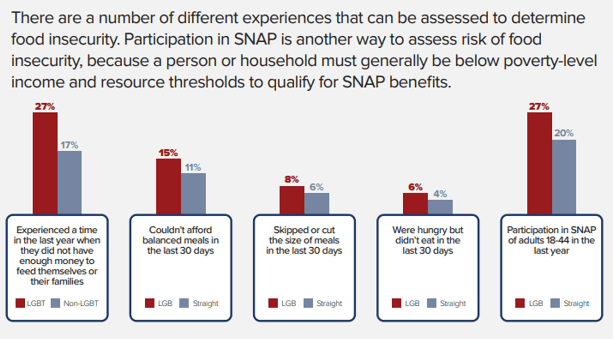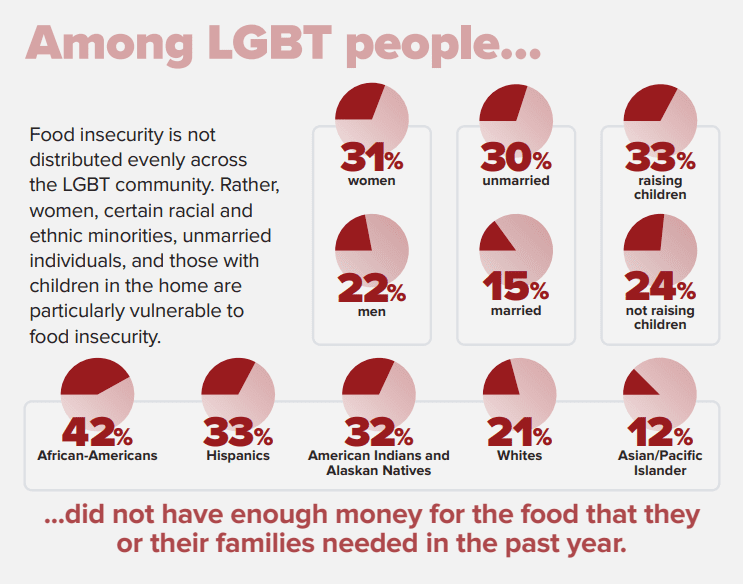What is food insecurity
People are described as “food insecure” when they have limited or uncertain access to adequate food. Analyses of multiple data sources demonstrate that food insecurity and SNAP (Supplemental Nutrition Assistance Program) participation are common among LGBT people, and that LGBT individuals and adults in same-sex couples often experience food insecurity and SNAP participation at higher levels than their non-LGBT and different-sex couple counterparts.
Key findings include:
- More than 1 in 4 LGBT adults (27%), approximately 2.2 million people, experienced a time in the last year when they did not have enough money to feed themselves or their families, compared to 17% of non-LGBT adults.
- 18% of LGB adults reported that they or someone in their family went without food for an entire day in the past 30 days.
- 14% of LGB adults reported running out of food for their families and not having money for more in the past 30 days.
- 9% of LGB adults reported that they ate less than they believed they should in the past 30 days.
- 6% of LGB adults reported going hungry in the past 30 days.


LGBTQ+ Food Insecurity
Food insecurity disproportionately affects LGBTQ+ people more than non-LGBTQ+ people. Contrary to popular stereotypes of the lesbian, gay, bisexual, and transgender (LGBT) community as affluent, research demonstrates not only widespread economic diversity among LGBT people but also that lesbian, gay, and bisexual (LGB) people are often more likely to be poor than straight people and that transgender individuals face extremely high rates of poverty.
Snap Participation
With respect to SNAP, key findings include:
More than 1 in 4 LGB adults aged 18-44 (27%) participated in SNAP, compared to 20% of non-LGB adults in that age range.
More than 1 in 10 adults in same-sex couples (11%) participated in SNAP, compared to 9% of adults in different-sex couples.
Food insecurity and SNAP participation are not distributed evenly across the LGB/T community. Rather, we find that women, younger people, certain racial and ethnic minorities, those without college degrees, unmarried individuals, and those with children in the home are particularly vulnerable to food insecurity.
Key findings include:
- Among LGBT people, 31% of women and 22% of men reported not having enough money for food in the past year.
- 31% of LGBT people aged 18-29 and 29% of LGBT people aged 30-49 reported not having enough money for food in the past year.
- Among LGBT people, 42% of African-Americans, 33% of Hispanics, 32% of American Indians and Alaskan Natives, and 21% of Whites reported not having enough money for food in the past year.
- 35% of LGBT people with a high school degree or less and 29% of LGBT people with some college education reported not having enough money for food in the past year.
- 30% of unmarried LGBT people and 15% of married LGBT people reported not having enough money for food in the past year.
- 33% of LGBT people raising children and 24% of LGBT people not raising children reported not having enough money for food in the past year.

